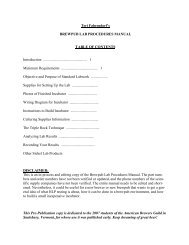New Lab Manual-2010SEP06.pub - Teri Fahrendorf
New Lab Manual-2010SEP06.pub - Teri Fahrendorf
New Lab Manual-2010SEP06.pub - Teri Fahrendorf
Create successful ePaper yourself
Turn your PDF publications into a flip-book with our unique Google optimized e-Paper software.
Lactobacillus is anaerobic (does not like oxygen), so it will affect your wort and beer before it<br />
is bottled or kegged. It grows best in a non-oxygen environment, such as your wort after it cools<br />
to 140 o F (60 o C) or less, and your beer before kegging. That is why it is so important to cool<br />
your wort fast and get your yeast in it as soon as possible. A slow start, not enough oxygen (or<br />
too much), or poor sanitation procedures will nearly guarantee the presence of this bacterium.<br />
Let's be careful out there!<br />
If your culture tubes sit in the incubator for a few extra days, the colonies will tend to spread<br />
out and will not be as recognizable. (See figure on previous page.) Sometimes, if your tubes sit<br />
in the incubator for an extra week or two, a formerly clean lab result will be seen to grow some<br />
small colonies. My guess is that you have a very weak Lactobacillus infection. With a strong<br />
start in the next brew, the yeast from that beer probably did not propagate these weak bacteria<br />
very much, however, caution should be used. If you are finding a lot of old tubes that are<br />
sprouting colonies, it would be prudent of you to order a fresh lot of liquid yeast.<br />
3. Pediococcus: White, swollen football-shaped colonies.<br />
Colonies will be suspended in the medium. Each football, or more accurately, rugby-ball, represents<br />
a colony that has grown from a single cell. The total number of colonies is important and<br />
should be recorded. The size of each individual colony is not important. Sometimes the colony<br />
can be surrounded by a white swirl that looks like cigarette smoke, and sometimes the colony<br />
can appear flat instead of three-dimensional.<br />
Pediococcus is a Lactic acid producer, as well as an even more prolific producer of Diacetyl. It<br />
is also anaerobic. It is considered more dangerous than Lactobacillus as it is harder to eradicate<br />
from the brewery. If your beer has this bacterium, please do not repitch the yeast.<br />
4. Generic aerobic bacteria: Cloudiness at top of the medium.<br />
Any cloudiness appearing in the top half-inch of the medium in the test tube indicates some sort<br />
of aerobic, or oxygen-loving bacteria. It is probably an acetic acid bacterium, which tastes like<br />
vinegar. It grows best in an oxygen-rich environment, such as your beer after aerating it, by accident,<br />
during bottling or kegging. That is why it is so important to counter-pressure fill kegs<br />
and bottles, and to keep the splashing down in all ways. This bacteria is aerobic, it loves oxygen,<br />
and needs it to grow.<br />
5. Any combination: of 2, 3, and 4 above is entirely possible.<br />
Any combination of lactobacillus, pediococcus, and aerobic bacterial infection is entirely possible.<br />
Test your spit to see what this looks like.<br />
15



